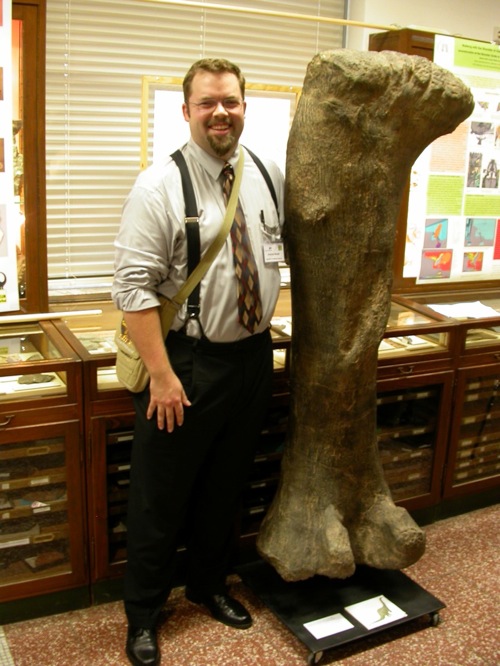 Dinosaur hunter Matt Wedel likes getting his hands dirty when he’s unearthing fossils of the biggest creatures that ever tromped the Earth. He has discovered and dug out gargantuan fossil bones of dinosaurs known as the Sauropods, which included Supersaurus, a 50-60 ton vegetarian that was as long from head to tail as three school buses.
Dinosaur hunter Matt Wedel likes getting his hands dirty when he’s unearthing fossils of the biggest creatures that ever tromped the Earth. He has discovered and dug out gargantuan fossil bones of dinosaurs known as the Sauropods, which included Supersaurus, a 50-60 ton vegetarian that was as long from head to tail as three school buses.
“Paleontology is a hands-on science. That’s one of the things I love about my job,” Wedel says. “You have to get your hands dirty, and the dirtier—the farther you get into the science.”
Wedel has also helped turn his dinosaur-hunting into earth science education, with such materials as the Big Dinos Return web site from the Lawrence Hall of Science and the Exploring Dinosaur Bones two-part activity at howtosmile.org.
Where Wedel’s scientific discoveries mean hands-on contact with ancient bones, learners' discoveries can involve touching something much more contemporary, like the leftover bones from yesterday’s dinner.
“Living material like bone, whether from a prehistoric dinosaur or modern-day bird, has a structure and a history,” he observes. “Birds are living dinosaurs, so looking at bird bones gives tremendous insight into dinosaur bones.”
In Exploring Dinosaur Bones, learners test cooked chicken or turkey bones, and find they’re made of more than just one kind of material. Paleontologists analyzing real T. rex bone have found different materials including red blood cells, and have used those cells to prove for the first time that a particular T. rex specimen was a female.
Even without a ready supply of chicken or turkey bones, learners can still have hands-on fun that replicates what paleontologists really do. All that’s needed is some small items like toothpicks or pebbles (even very small toys), some water, and toilet paper.
Toilet paper?
Wedel explains that paleontologists often cover bigger fossils first with wet toilet paper, then put hardening plaster over that. For tiny fossil pieces, wet toilet paper covered with masking tape is enough to keep brittle pieces safe, even on long journeys from the field site to a museum or laboratory.
“Being a dinosaur scientist calls for innovation, imagination and creativity based on facts,” says Wedel, who teaches at Western University of Health Sciences. “Kids who are interested in fossils can come at paleontology from many different perspectives.” He suggests having learners role play a team of dinosaur scientists, who unearth fossils, compare them to other fossils, reconstruct them to approximate their full skeletons, and do tests on fossil tissue to discover things like how fast an animal grew.
He also encourages kids to imagine the world a particular dinosaur lived in—like T. rex, for example. How much did it need to eat to survive? How did it spend its day? How did it deal with protecting its young?
To help kids picture of dinosaurs as living, moving, full-bodied animals, instead of dead, unmoving piles of bones, Wedel says start with something like a video of wildebeest and lions on the Serengeti. Then “tweak it, to use it as a model for imagining dinosaur predators and prey that weighed TEN TIMES MORE than these modern animals!”
